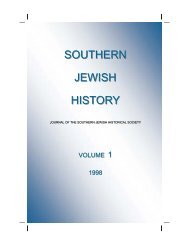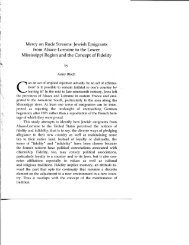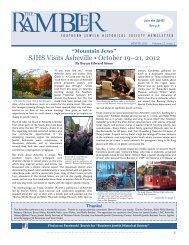A Shtetl Grew in Bessemer - Southern Jewish Historical Society
A Shtetl Grew in Bessemer - Southern Jewish Historical Society
A Shtetl Grew in Bessemer - Southern Jewish Historical Society
Create successful ePaper yourself
Turn your PDF publications into a flip-book with our unique Google optimized e-Paper software.
BARR/A SHTETL GREW IN BESSEMER 37<br />
course, his bus<strong>in</strong>ess from 1902 to his death <strong>in</strong> 1966 was The Kartus<br />
Korner.<br />
The 1998 American <strong>Jewish</strong> Year Book lists only seven cities<br />
<strong>in</strong> Alabama with <strong>Jewish</strong> populations over 100 people, with<br />
250 <strong>Jewish</strong> people categorized as liv<strong>in</strong>g <strong>in</strong> “other places.” 152 In<br />
the follow<strong>in</strong>g year only one <strong>Jewish</strong>-owned bus<strong>in</strong>ess rema<strong>in</strong>ed<br />
<strong>in</strong> <strong>Bessemer</strong>: Torme Foods, run by Merv and Marv<strong>in</strong> Torme,<br />
who do not reside <strong>in</strong> the city. 153 In a town whose population as<br />
of 1999 is approximately thirty-five thousand, there are only<br />
four <strong>Jewish</strong> <strong>in</strong>dividuals. Their words offer a perspective on the<br />
fullness, irony, and sorrow of the life and death of <strong>Jewish</strong><br />
<strong>Bessemer</strong>.<br />
Nat Wittenste<strong>in</strong>, who came to <strong>Bessemer</strong> from Brooklyn, New<br />
York, <strong>in</strong> the late 1940s and ran a cloth<strong>in</strong>g bus<strong>in</strong>ess on First Avenue<br />
for over thirty years (variously known as Grand, State, and Dixie<br />
Cloth<strong>in</strong>g), was happy liv<strong>in</strong>g <strong>in</strong> <strong>Bessemer</strong>: “I have no licks aga<strong>in</strong>st<br />
<strong>Bessemer</strong>. If I did, I’d go live with my kids. No, <strong>Bessemer</strong> is f<strong>in</strong>e.<br />
I’ve had no rough times here.” 154<br />
Alv<strong>in</strong> Barr, whose grandfather owned Barr Hatters and who<br />
moved to <strong>Bessemer</strong> <strong>in</strong> 1952, when he married Jo Ann Terry, grew<br />
to love the city. But before his move, while travel<strong>in</strong>g back and<br />
forth <strong>in</strong> 1946 from his home <strong>in</strong> Birm<strong>in</strong>gham to the University of<br />
Alabama <strong>in</strong> Tuscaloosa, his Greyhound bus always stopped <strong>in</strong><br />
<strong>Bessemer</strong>: “I remember the <strong>Bessemer</strong> bus station, and I also remember<br />
say<strong>in</strong>g ‘Boy, this is one place I’ll never live’. . . . <strong>Bessemer</strong><br />
looked like a little run-down town to me, compared to Birm<strong>in</strong>gham.<br />
Of course, when you make statements like that you live to<br />
regret them.” 155<br />
As for Buddy Sokol (whose wife Polly is the fourth <strong>Jewish</strong><br />
resident), the memories are bittersweet:<br />
The only th<strong>in</strong>g that bothers me is how the <strong>Jewish</strong> people have<br />
more or less migrated, because we had a viable <strong>Jewish</strong> community<br />
here and we were respected because we had the temple and<br />
kept it up. And to the end people admired the fact that only fifteen<br />
or so families could keep the temple go<strong>in</strong>g. I’m proud of our<br />
cemetery . . . proud of the fact that it will keep go<strong>in</strong>g when I’m







